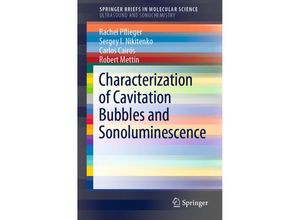This book presents the latest research on fundamental aspects of acoustic bubbles and in
particular on various complementary ways to characterize them. It starts with the dynamics of a
single bubble under ultrasound and then addresses few-bubble systems and the formation and
development of bubble structures before briefly reviewing work on isolated bubbles in standing
acoustic waves (bubble traps) and multibubble systems where translation and interaction of
bubbles play a major role. Further it explores the interaction of bubbles with objects and
highlights non-spherical bubble dynamics and the respective collapse geometries. It also
discusses the important link between bubble dynamics and energy focusing in the bubble leading
to sonochemistry and sonoluminescence. The second chapter focuses on the emission of light by
cavitation bubbles at collapse (sonoluminescence) and on the information that can be gained by
sonoluminescence (SL) spectroscopy e.g. the conditions reached inside the bubbles or the
nature of the excited species formed. This chapter also includes a section on the use of SL
intensity measurement under pulsed ultrasound as an indirect way to estimate bubble size and
size distribution. Lastly since one very important feature of cavitation systems is their
sonochemical activity the final chapter presents chemical characterizations the care that
should be taken in using them and the possible visualization of chemical activity. It also
explores the links between bubble dynamics SL spectroscopy and sonochemical activity. This
book provides a fundamental basis for other books in the Molecular Science: Ultrasound and
Sonochemistry series that are more focused on applied aspects of sonochemistry. A basic
knowledge of the characterization of cavitation bubbles is indispensable for the optimization
of sonochemical processes and as such the book is useful for specialists (researchers
engineers PhD students etc.) working in the wide area of ultrasonic processing.

